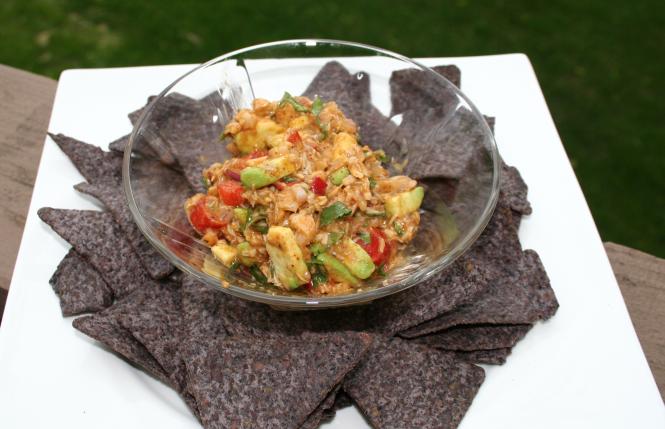This is the eighth post in a series about hunting for food -- truly meeting your meat. Also check out the earlier posts from the series: Squirrel Hunting with Mom, Duck Hunting, An Unsuccessful Pheasant Hunt, Mom Bags Her First Deer, Ice Fishing, Making Your Own Sausages, Wild Game Charcuterie, and Foraging.
You know you are about to have a good time when the activity you are about to do requires a waiver. That’s what my friend Rick said to me right before we got onto a boat for an evening of bowfishing. Bowfishing isn’t a new way to fish, but it was new to Rick and me; I have always wanted to try it, but it can be a little expensive to buy a bow and set it up with all the necessary gear. Several weeks ago, I was searching through Craigslist trying to find an old bow to buy when I came across an ad for guided bowfishing trips. I immediately went to the website and sent an inquiry to find out more information. As soon as I told my good friend Rick Edwards about it, he was on board, and we were all set to go.
Derek Sanderson runs Scales-n-Tales bowfishing guide service, taking people out for guided bowfishing hunts in the west metro area, primarily searching for carp but targeting all varieties of rough fish. I set up a trip for me and Rick, and we met Derek at 8:30 p.m. on a calm Tuesday evening for an experience I won’t soon forget. Before we set out, we went through some safety tips and the basic workings of the bows we were going to be using. The bows use special arrows that are attached to the bow with 200 pound line, and they are also equipped with fishing reels designed specifically for bowfishing. Derek’s boat is a standard 16 foot flat bottom boat that he has modified to include an elevated shooting deck on the front and high power lights that illuminate the water and allow you to see the fish.
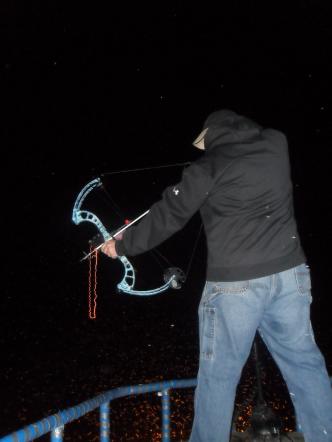 I had told
Derek that I was a first timer, and he informed me that going at night provides
a better opportunity for beginners because the fish are easier to see. When we
started out, Rick and I were both curious what the best method for shooting
carp was going to be. Derek told us that when you are shooting into the water
you need to aim low, and when you think you have aimed low enough, aim lower.
Because of the refractory of the water, the fish appear to be right under the
surface but in all actuality the fish we were shooting at were in one to four
feet of water and the majority of our misses went high over the fish. It took
several shots to get the hang of it and even when we did get the hang of it
there were still a lot of missed shots.
I had told
Derek that I was a first timer, and he informed me that going at night provides
a better opportunity for beginners because the fish are easier to see. When we
started out, Rick and I were both curious what the best method for shooting
carp was going to be. Derek told us that when you are shooting into the water
you need to aim low, and when you think you have aimed low enough, aim lower.
Because of the refractory of the water, the fish appear to be right under the
surface but in all actuality the fish we were shooting at were in one to four
feet of water and the majority of our misses went high over the fish. It took
several shots to get the hang of it and even when we did get the hang of it
there were still a lot of missed shots.
The first fish of the night was a decent sized carp about 5-6 pounds; this was the size we were looking for. When I first contacted Derek to set up the trip, I told him that I really wanted some decent fish for eating. Derek chose the lake we were on because the fish tend to be a little smaller and better for eating. Some of the other lakes that Derek guides on can produce fish in the 20-30 pound range, and when they get that big they aren’t very good to eat. All the fish we got that night were in the 5-8 pound range. It took about three hours to make a complete circle around the lake and in that time we got six carp and one dogfish. We lost one of the carp because it came off the arrow.
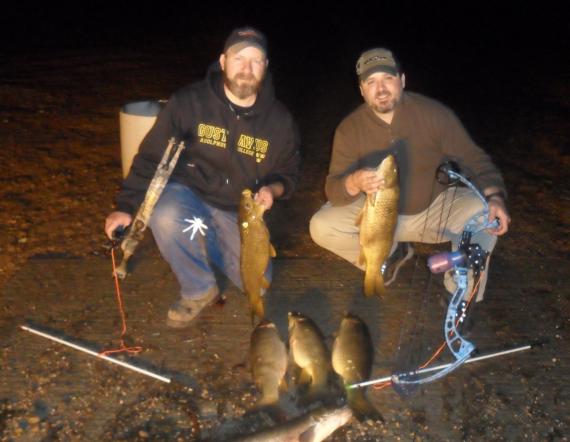
Bowfishing turned out to be one of the most entertaining activities I have ever done. It was non-stop action from the time we got on the boat until we finished. We got plenty of shooting in, but shooting wasn’t the only thing we did. The way the lights shine into the water, they illuminate an area around the boat and you can see everything in the water. We saw hundreds of different fish including a few trophy-sized northern pike that would be a blast to catch, but bowfishing is limited to rough fish only. Game fish like Northerns, walleyes and bass are illegal to take with a bow. We also saw dozens of turtles, both painted turtles and snapping turtles; a couple of the snapping turtles were as big around as a garbage can lid. While back in a small bay we came across several geese. They got spooked and took off, but one of the geese didn’t get off the water in time and flew right into me, almost knocking me off the boat. That was a first for me.
Rick and I had a blast, and we are looking forward to going back and doing it again. We were both really excited to get some carp and wanted to try out a few recipes to see if we could make carp taste better than its reputation would lead you to believe. Most people don’t eat carp; as a matter of fact, Derek told us that we were the first of his clients to request to take them home. Usually he gets rid of the carp and uses it for compost. But I felt like I was up to the challenge to take a fish that most people won’t eat and make something delicious out of it.
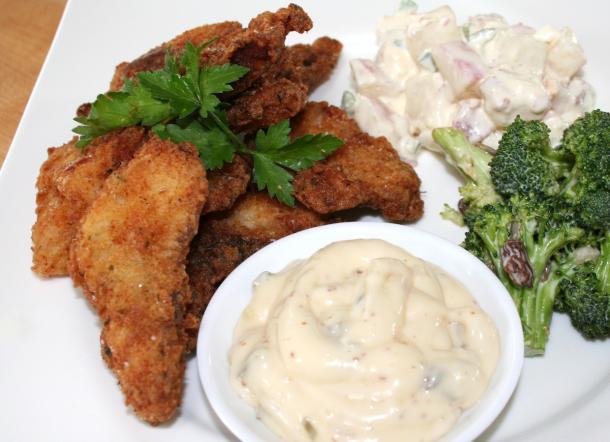
I have eaten carp before, but I’ve only ever seen it cooked two different ways: smoked and fried. Smoked carp is good and all of the fried carp I have had has been pretty good, as well. One of the big complaints about carp is that it can taste swampy, or have a mushy texture. In order to get around that there is a technique of handling fish that everyone should know about called bleeding your fish. After you catch a fish, if you intend on eating it, you should cut the gills out and make a cut across the throat of the fish. This will allow the fish to completely bleed out, and when you do this it takes a lot of that bad flavor with it. The other thing that has to be done is removing the dark flesh from the inside of the fillet. It is often referred to as the mud stripe, because it can taste just like the bottom of the lake. When those two things are done, carp are just as tasty as any other fish. I would agree with my buddy Rick that they are on the same plane as an orange roughy or a tilapia.
The other big problem with carp is that they are extremely boney. Not only is the rib cage very large but the best part of the fillet is riddled with these crazy Y-bones that are a complete pain. One method for dealing with all the bones is scoring the meat. Scoring is when you take the fillet and make dozens of cuts in the fillet not going all the way through the fillet. When done properly, it allows the oil you are frying the fish in to penetrate the meat, which softens the bones and makes them edible.
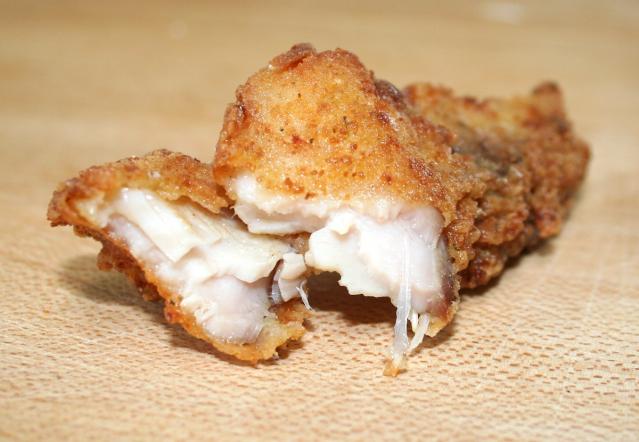 I cooked my
carp in two different ways. First, I cut some of my fillets into nuggets and
soaked them in buttermilk and made buttermilk fried carp nuggets. They were
wonderful, with a great texture and mild flavor, and the meat just flaked
apart. The second way I cooked the carp was to make a ceviche. A true ceviche
is fish that has been soaked in lime or other citrus juice, and the acidity
essentially cooks the fish. But since carp are fresh water fish, which can be
susceptible to parasites, it's necessary to freeze or cook them in order to kill
any possible parasites. I
decided to poach the fillets first and then soak them in lime juice; poaching
the fillets first also gave me the opportunity to pick out all the bones in the
meat. What I ended up with was a very appealing carp ceviche, and unless I told
you it was carp I doubt anyone would be able to tell the difference between it
and any other fish.
I cooked my
carp in two different ways. First, I cut some of my fillets into nuggets and
soaked them in buttermilk and made buttermilk fried carp nuggets. They were
wonderful, with a great texture and mild flavor, and the meat just flaked
apart. The second way I cooked the carp was to make a ceviche. A true ceviche
is fish that has been soaked in lime or other citrus juice, and the acidity
essentially cooks the fish. But since carp are fresh water fish, which can be
susceptible to parasites, it's necessary to freeze or cook them in order to kill
any possible parasites. I
decided to poach the fillets first and then soak them in lime juice; poaching
the fillets first also gave me the opportunity to pick out all the bones in the
meat. What I ended up with was a very appealing carp ceviche, and unless I told
you it was carp I doubt anyone would be able to tell the difference between it
and any other fish.
If you are looking for a summer adventure and would like to give it a try, bowfishing is definitely an entertaining option. And if you are looking for a challenge beyond hitting a fish with an arrow, take the carp home and try making something tasty. Both activities will be worth your time.
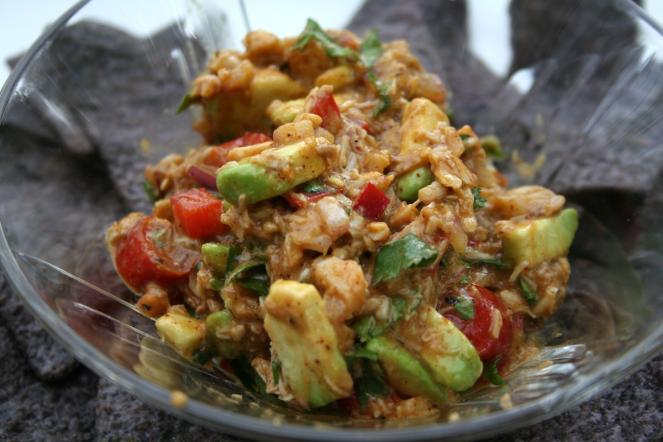
Carp Ceviche
Serves 12 with ½ cup portions
Ingredients:
- 2 cups carp (poached and picked over for bones)
- ½ cup finely diced red onion
- ¼ cup diced red pepper
- 1 jalapeno finely diced
- ½ cup diced cherry tomatoes
- ¼ cup freshly squeezed lime juice
- ½ cup chopped cilantro
- ¼ cup olive oil
- 2 avocados diced
- ½ tsp Ancho Chile powder
- ½ tsp ground cumin
- Salt and pepper to taste
Instructions:
- Poach the carp fillets in well-seasoned salt water and allow to cool to room temperature.
- Pick over the fillets and remove all the Y-bones until you have about 2 cups of cooked carp.
- Pour the lime juice over the carp and let stand while you cut and mix the remaining ingredients.
- Dice the remaining ingredients and mix in a large bowl. Once all the ingredients are added together, add the carp meat and the lime juice and stir gently together. Season with salt and pepper and serve chilled. I served mine with blue corn chips.

Jamie Carlson lives in Burnsville, MN with his wife, Amanda, and their two kids Eleanor and Charlie. He works as an Rn at the Minneapolis VA hospital. He enjoys hunting, fishing, foraging, and, of course, cooking. He believes that all food can be tasty if it is prepared with care, and he writes about his adventures cooking everything from Pickled Venison Heart to Roasted Dove on his food blog, You Have to Cook it Right. Follow him at @youcookitright. His last post for SGT was Foraging (Stinging Nettles, Morels, and Ramps).

